Developing and implementing the National Adaptation Plan (NAP) Process in Burundi

Developing and implementing the National Adaptation Plan (NAP) Process in Burundi
As climate change intensifies, Burundi will experience a shift in seasons and unpredictable weather patterns. This is projected to cause increased flooding, land degradation, loss of soil fertility, shortages of groundwater resources during dry periods, increased frequency of extreme weather events, changes in agricultural seasons and unpredictable phytosanitary phenomena. The most affected sectors include agriculture, livestock and forestry, water resources, natural ecosystems, energy, human health and infrastructure and transport1. Indeed, climate change will result in a decrease in agricultural and food production, including fish production, as well as the persistence of energy shortage, a deterioration of the health of the population and a lack of financial resources to invest in sustainable development. 2
The Government has been addressing the immediate impacts of climate change through the National Adaptation Programme of Action (NAPA) submitted to the UNFCCC in 2006. It also developed a National Policy on Climate Change (NPCC) to serve as the overarching strategy on climate change in 2012. Through the NPCC, the Government presented their vision and principles. In 2013, the Government prepared a National Strategy and Action Plan on Climate change (NSAPCC) to operationalize the NPCC. Building on these efforts, it is now committed to following the orientations contained in the NPCC and NSAPCC while considering emerging needs, including the need for more in-depth climate and vulnerability assessments in the key sectors of development.
In August 2014, Burundi initiated its National Adaptation Plan (NAP)process and identifiedinitial barriers to effective adaptation planning and implementation. A 2016 stocktaking exercise provided an opportunity to revisit and update these barriers, as below:
- Limited availability and accessibility of climate-relevant information
- Lack of an operational framework for long-term adaptation planning
- Limited technical skills, including the ability to assess climate risks and vulnerabilities, identify and appraise adaptation options and the ability to plan and communicate regarding adaptation
- Limited ability to mobilize resources for climate change
Guided by the strategic direction set by the NPCC and NSAPCC and the gaps identified, this project aims to provide an operational foundation for effective adaptation investment in Burundi in the short-, medium- and long- term.